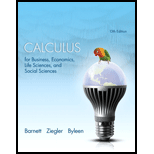
Problems 91–94 refer to the following: If a decrease in demand for one product results in an increase in demand for another product, the two products are said to be competitive, or substitute,
products. (Real whipping cream and imitation whipping cream are examples of competitive, or substitute, products.) If a decrease in demand for one product results in a decrease in demand for another product, the two products are said to be complementary products. (Fishing boats and outboard motors are examples of complementary products.) Partial derivatives can be used to test whether two products are competitive, complementary, or neither. We start with demand functions for two products such that the demand for either depends on the prices for both:
The variables x and y represent the number of units demanded of products A and B, respectively, at a price p for 1 unit of product A and a price q for I unit of product B. Normally, if the price of A increases while the price of B is held constant, then the demand for A will decrease; that is, fp(p, q) < 0. Then, if A and B are competitive products, the demand for B will increase; that is, gr(p, q) > 0. Similarly, if the price of B increases while the price of A is held constant, the demand for B will decrease; that is, gq(p, q) < 0. Then, if A and B are competitive products, the demand for A will increase; that is, fq(p, q) > 0. Reasoning similarly for complementary products, we arrive at the following test:
Test for Competitive and Complementary Products
| Partial Derivatives | Products A and B |
| fq(p, q) > and gp(p, q) > 0 | Competitive (substitute) |
| fq(p, q) < and gp(p, q) < 0 | Complementary |
| fq(p, q) ≥ and gp(p, q) ≤ 0 | Neither |
| fq(p, q) ≤ and gp(p, q) ≥ 0 | Neither |
Use this test in Problems 91-94 to determine whether the indicated products are competitive, complementary, or neither.
93. Product demand. The monthly demand equations for the sale of skis and ski boots in a sporting goods store are
Want to see the full answer?
Check out a sample textbook solution
Chapter 7 Solutions
Calculus for Business Economics Life Sciences and Social Sciences Plus NEW
- A sequence X = (xn) is said to be a contractive sequence if there is a constant 0 < C < 1 so that for all n = N. - |Xn+1 − xn| ≤ C|Xn — Xn−1| -arrow_forward3) Find the surface area of z -1≤ y ≤1 = 1 + x + y + x2 over the rectangle −2 ≤ x ≤ 1 and - Solution: TYPE YOUR SOLUTION HERE! ALSO: Generate a plot of the surface in Mathematica and include that plot in your solution!arrow_forward7. Walkabout. Does this graph have an Euler circuit? If so, find one. If not, explain why not.arrow_forward
- Below, let A, B, and C be sets. 1) Prove (AUB) nC = (ANC) U (BNC).arrow_forwardQ1: find the Reliability of component in the system in fig(1) by minimal cut method. Q2: A component A with constant failure rate 1.5 per 1000 h, B per to 2 in 1000h, A and B in parallel, find the Reliability system? [ by exponential distribution]. Q3: Give an example to find the minimal path and estimate the reliability of this block diagram. Q4: By Tie set method find the Reliability of fig (2) FUZarrow_forwardA sequence X = (xn) is said to be a contractive sequence if there is a constant 0 < C < 1 so that for all n = N. - |Xn+1 − xn| ≤ C|Xn — Xn−1| -arrow_forward
- 1) Suppose continuous random variable X has sample space S = [1, ∞) and a pdf of the form f(x) = Ce-(2-1)/2. What is the expected value of X?arrow_forwardA sequence X = (xn) is said to be a contractive sequence if there is a constant 0 < C < 1 so that for all n = N. - |Xn+1 − xn| ≤ C|Xn — Xn−1| -arrow_forward1) Find the equation of the tangent line to the graph y=xe at the point (1, 1).arrow_forward
 Linear Algebra: A Modern IntroductionAlgebraISBN:9781285463247Author:David PoolePublisher:Cengage Learning
Linear Algebra: A Modern IntroductionAlgebraISBN:9781285463247Author:David PoolePublisher:Cengage Learning

